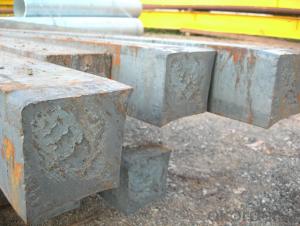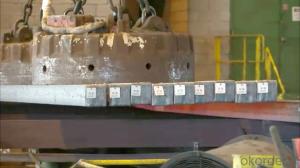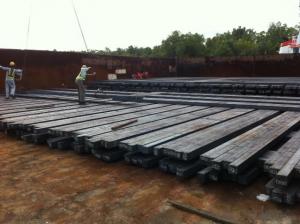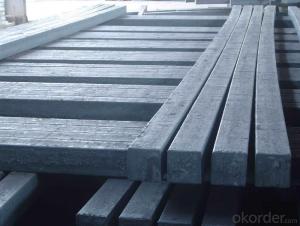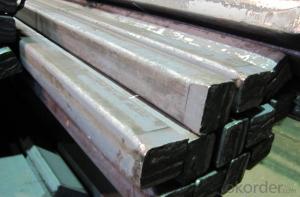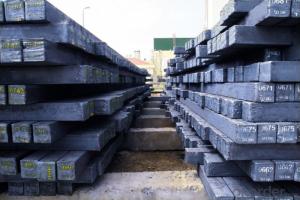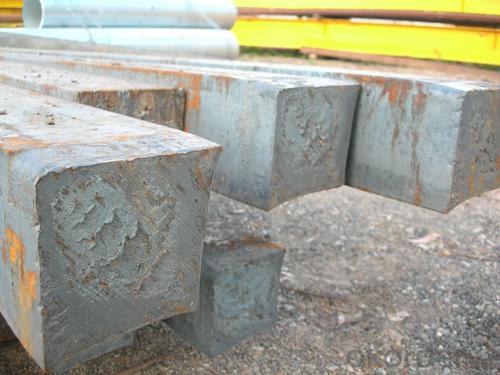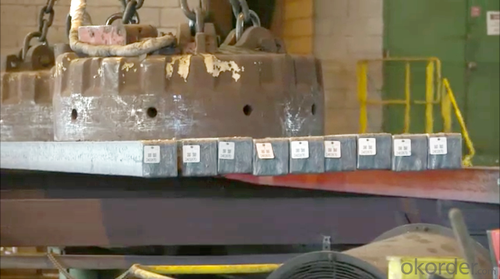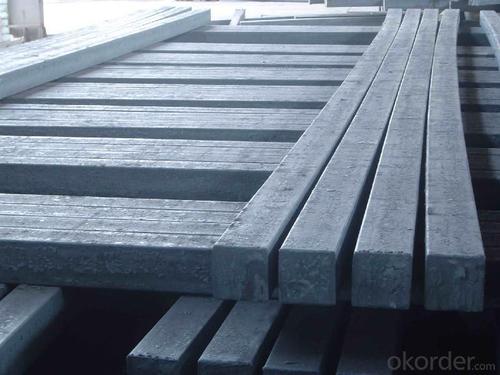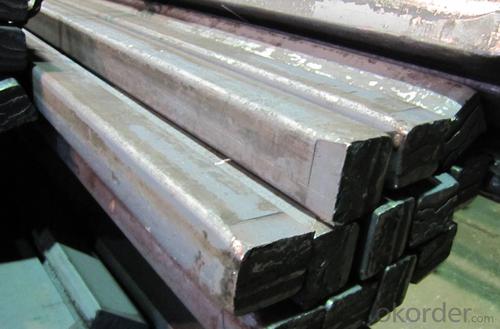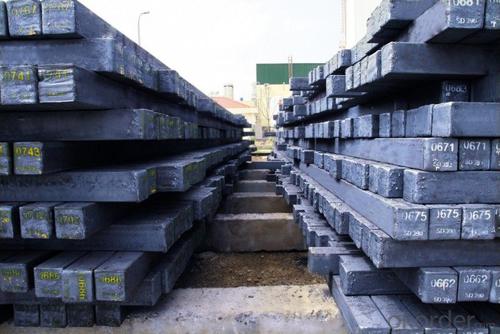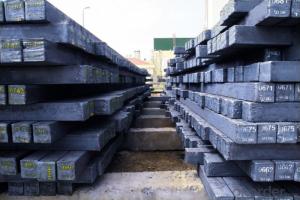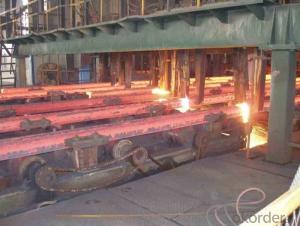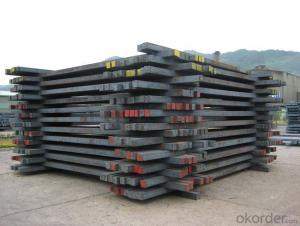Hot Rolled Steel Billet 3SP Standard 160mm
- Loading Port:
- Shanghai
- Payment Terms:
- TT OR LC
- Min Order Qty:
- 100 m.t.
- Supply Capability:
- 10000 m.t./month
OKorder Service Pledge
OKorder Financial Service
You Might Also Like
Structure of Hot Rolled Steel Billet 3SP Standard 160mm

Description of Hot Rolled Steel Billet 3SP Standard 160mm
Prepainted Rolled steel Coil is a kind of coated steel coil/sheet. With the cold rolled steel of different strength and thickness as substrate, it is produced through applying Al-Zn coat on both faces by hot dip process. In its coating, Al accounts for about 55%, Si 1.6%, while the remaining is Zn. Aluminum zinc coils enjoys both the physical protective feature and durability of Al and the electrochemical protective property of Zn. And its surface has bright silver color and regular embossed-like figure, which are highly decorative. RAL Scale Z35 Prepainted Rolled Steel Coil for Construction Roofing

Main Feature of Hot Rolled Steel Billet 3SP Standard 160mm
1.Corrosion resistance: It mainly depends on the zinc protection. When the zinc being worn,
2. Heat resistance: steel sheet has excellent heat resistance, can withstand high temperatures over 300 centigrade, and is similar with aluminized steel high temperature oxidation resistance. It often used in chimney pipes, ovens, fluorescent lighting device and the device cover.
3. Heat reflective: Galvanized steel plate heat-reflective high rate is twice as galvanized steel, often used to make insulation materials. RAL Scale Z35 Prepainted Rolled Steel Coil for Construction Roofing
Applications of Hot Rolled Steel Billet 3SP Standard 160mm
1. Construction and building: roofing; ventilating duct; handrail; partition panel;etc.
2. Electric appliance: refrigerator; washing machine; refrigerator; DVD;etc.
3.Transportation: oil tank; gas tank;road sign; etc.
4.Agriculture constructions :barn; etc.RAL Scale Z35 Prepainted Rolled Steel Coil for Construction Roofing
5.Others:vending machine; game machine; auto parts spare parts etc.
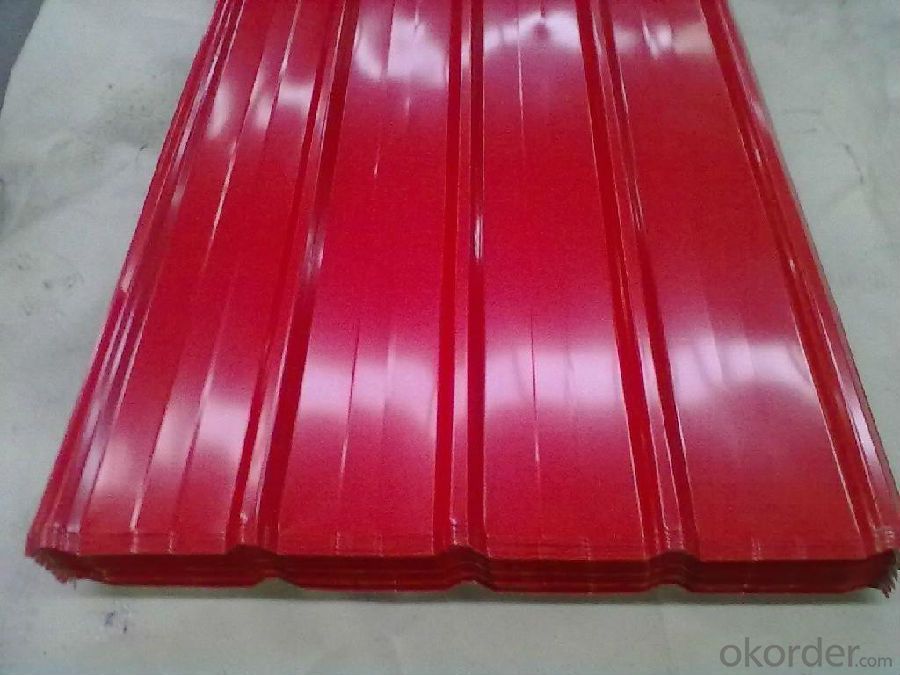
Specifications of Hot Rolled Steel Billet 3SP Standard 160mm
Product | Hot Rolled Steel Billet 3SP Standard 160mm |
Material Grade | SGCC / SGCH / DX51D+AZ, etc |
Thickness | 0.5-3.0mm |
Width | 700-1500mm |
Tolerance | Thickness: +/-0.02mm , Width:+/-2mm |
Zinc-coating | AZ30-150g/m2 |
Technique | Raw material: Hot rolled steel coil --> Cold rolled_>hot dipped galvalume |
Surface | Dried, Chromated, Unoiled,RAL Scale Z35 Prepainted Rolled Steel Coil for Construction Roofing |
Spangle | Regular spangle , small spangle, zero spangle |
ID | 508MM 610MM |
Coil weight | 25MT max |
Export package | Cardboard inner sleeves, Waterproof paper, galvanized steel covered and steel strip packed |
FAQ of Hot Rolled Steel Billet 3SP Standard 160mm
We have organized several common questions for our clients,may help you sincerely:
1. What is the minimum order quantity ?
Our MOQ is 100 mt for each size each specification. Usually we can offer discount if can buy large QTY once. RAL Scale Z35 Prepainted Rolled Steel Coil for Construction Roofing
2. How long can we receive the product after ordering?
Our general delivery time is 30 days after confirmation, but so some special orders, we have offer special delivery time
3. How to guarantee the quality of the products?
We have established the international advanced quality management system ,every link from raw material to final product we have strict quality test;We resolutely put an end to unqualified products flowing into the market. At the same time, we will provide necessary follow-up service assurance.
4. What is the payment?
We accept T/T, L/C
- Q: Can steel billets be coated for improved aesthetic appearance?
- Yes, steel billets can be coated with various materials such as paints, lacquers, or powder coatings to enhance their aesthetic appearance.
- Q: What are the different methods of steel billet surface painting?
- Various industries commonly use several different methods for painting the surface of steel billets. These methods include: 1. Spray painting: A spray gun is utilized to apply a thin and even layer of paint onto the steel billet surface. This method ensures a smooth and consistent finish, allowing for efficient coverage. 2. Powder coating: An electrostatic charge is used to apply a dry powder to the steel billet surface. The powder adheres to the surface and is then heated to create a durable and long-lasting coating. Powder coating offers excellent resistance against corrosion, chemicals, and abrasion. 3. Electroplating: The steel billet is immersed in a solution containing a metal salt. By applying a direct current, the metal ions in the solution are deposited onto the billet surface. This method enhances the appearance and durability of the steel, providing a protective and decorative coating. 4. Hot-dip galvanizing: The steel billet is immersed in a bath of molten zinc. The zinc forms a protective layer on the billet surface, offering exceptional corrosion resistance. Hot-dip galvanizing is commonly used for outdoor applications where the steel is exposed to harsh environmental conditions. 5. Epoxy coating: Epoxy coatings are applied as a two-part system, combining a resin and a hardener that are then applied to the steel billet surface. The epoxy cures to create a tough and chemical-resistant coating, protecting against corrosion and abrasion. 6. Electrophoretic painting: The steel billet is immersed in a tank containing a paint solution, and an electric current is applied. The electric charge causes the paint particles in the solution to migrate towards the billet surface, resulting in a uniform and consistent coating. Each method has its own advantages and disadvantages, and the choice of method depends on factors such as the desired finish, the environment in which the steel billet will be used, and the required level of protection.
- Q: How are steel billets used in the production of electrical appliances?
- Steel billets are used in the production of electrical appliances as a raw material that is shaped and formed into various components such as casings, frames, brackets, and other structural parts. These billets are melted, cast, and rolled into the desired shape and size, providing the necessary strength, stability, and durability required for electrical appliances.
- Q: What is the role of steel billets in the manufacturing of agricultural machinery?
- Steel billets play a crucial role in the manufacturing of agricultural machinery as they serve as the raw material for various components. These billets are heated, shaped, and machined to create parts such as gears, shafts, axles, and frames. The strength, durability, and versatility of steel make it an ideal choice for agricultural machinery, enabling it to withstand heavy loads, extreme weather conditions, and constant use in the field.
- Q: How often is it? What is the range of temperature in the process of rolling? What is the temperature of the final rolling?
- Cold rolling is not consideredThe temperature at which the billet begins to roll (surface) is generally 1000-1150 degrees
- Q: Are steel billets used in the production of construction equipment?
- Yes, steel billets are commonly used in the production of construction equipment. Steel billets serve as the raw material for various components and parts of construction equipment, such as frames, chassis, brackets, and support structures. The high strength and durability of steel make it a preferred choice in the construction industry, ensuring the equipment's ability to withstand heavy loads and harsh working conditions.
- Q: What are the potential applications of steel billets in the automotive sector?
- Steel billets have a wide range of potential applications in the automotive sector due to their strength, durability, and versatility. They can be used to manufacture various automotive components such as engine parts, chassis, suspension systems, and transmission components. Additionally, steel billets can be shaped and formed into different sizes and shapes to meet the specific requirements of automotive manufacturers. Overall, their potential applications in the automotive sector contribute to the production of safer, more efficient, and reliable vehicles.
- Q: What are the key factors driving the demand for steel billets?
- There are several key factors driving the demand for steel billets. Firstly, the construction industry plays a significant role in boosting the demand for steel billets. Steel is widely used in construction projects for various purposes, such as structural framing, reinforcement, and support systems. As urbanization continues to grow and infrastructure projects increase, the demand for steel billets also rises. Additionally, the automotive industry is a major driver of steel billet demand. Steel is a crucial material in the manufacturing of automobiles, including car bodies, chassis, and engine components. As the global automotive industry expands and consumers demand more vehicles, the demand for steel billets increases accordingly. Moreover, the energy sector contributes to the demand for steel billets, particularly in the production of oil and gas pipelines. Steel billets are used to manufacture seamless pipes, which are essential for the transportation of oil and gas over long distances. As the demand for energy continues to rise, so does the need for steel billets to support pipeline construction. Furthermore, the manufacturing and machinery industries rely heavily on steel billets. From industrial machinery to consumer products, steel is a fundamental material used in various manufacturing processes. As these industries grow and evolve, the demand for steel billets remains steady. Lastly, the global economic growth and industrialization in emerging markets have a significant impact on the demand for steel billets. Countries with rapidly developing economies, such as China and India, are major consumers of steel billets as they undergo massive infrastructure projects and industrial expansion. Overall, the demand for steel billets is primarily driven by the construction industry, automotive sector, energy sector, manufacturing industry, and global economic growth. These factors collectively contribute to the sustained and growing demand for steel billets in the market.
- Q: How are steel billets used in the manufacturing of hydraulic components?
- Hydraulic components rely heavily on steel billets as a crucial raw material for their production. Billets, which are essentially semi-finished steel forms, are typically rectangular or square in shape. They undergo further processing to become various hydraulic components like cylinders, pistons, valves, and fittings. The manufacturing process begins by carefully selecting high-quality steel billets that meet specific mechanical and chemical requirements. These billets are then heated to a specific temperature, making them more malleable and easier to shape. Once heated, the billets undergo a series of mechanical processes such as forging, extrusion, or rolling to achieve the desired shape and size. For instance, in the production of hydraulic cylinders, the heated billets are usually forged or extruded to form the cylinder body. This involves applying high pressure to the billet, causing it to deform and take on a cylindrical shape. The resulting cylinder body is then further machined to precise tolerances to accommodate internal components like pistons, seals, and valves. Similarly, hydraulic valves and fittings are also manufactured using steel billets. The billets undergo various machining techniques such as turning, milling, drilling, and grinding to create intricate shapes and features required for these components. The final products are then subjected to heat treatment or surface treatment to enhance their strength, durability, and corrosion resistance. Steel billets are preferred in the manufacturing of hydraulic components due to their exceptional mechanical properties, including high strength, good ductility, and weldability. These properties ensure that the components can withstand the high pressures, extreme temperatures, and harsh operating conditions commonly experienced in hydraulic systems. In conclusion, steel billets play a vital role in the manufacturing process of hydraulic components. They undergo various mechanical processes to achieve the necessary shapes and sizes needed for cylinders, pistons, valves, and fittings. The use of steel billets guarantees the production of high-quality and reliable hydraulic components that can effectively function in demanding hydraulic systems.
- Q: How do steel billets contribute to the overall safety of a structure?
- A structure's overall safety is greatly influenced by steel billets in several ways. To begin with, steel billets act as the raw material for producing steel bars, beams, columns, and other structural components. These components are widely utilized in construction due to their exceptional strength and durability. By utilizing steel billets as the starting material, the resulting steel products display outstanding load-bearing capacity, thereby bolstering the structural integrity of the building. Furthermore, steel billets undergo a rigorous manufacturing process that encompasses various quality control assessments. These assessments ensure that the billets possess consistent and dependable mechanical properties, such as high tensile strength and impact resistance. Consequently, when these billets are employed in constructing a structure, they contribute to its overall safety by providing a dependable and robust framework capable of withstanding external forces like wind, earthquakes, or heavy loads. Additionally, advanced metallurgical techniques, such as controlled cooling or heat treatment, are frequently employed to produce steel billets with specific properties required for structural applications. These processes aid in enhancing the steel's microstructure, reducing internal defects, and improving its resistance to corrosion, fatigue, and other forms of degradation. In turn, this prolongs the structure's lifespan and minimizes the risk of structural failure, ensuring the safety of its occupants. Moreover, steel billets can be manufactured with precise dimensions and tolerances, permitting accurate and efficient construction. This precision in fabrication ensures that structural components fit together seamlessly, reducing the likelihood of gaps, misalignments, or weak points that could compromise the structure's safety. Lastly, steel billets are highly recyclable, making them an environmentally friendly choice for construction. By opting for steel billets, the construction industry can diminish its carbon footprint and contribute to sustainable development. This focus on sustainability aligns with the structure's overall safety, as a sustainable approach guarantees the long-term stability and resilience of the built environment. In conclusion, steel billets enhance the overall safety of a structure by providing construction materials that are strong, durable, and reliable. Their consistent mechanical properties, resistance to external forces, improved microstructure, and precise fabrication ensure a sturdy and secure framework. Additionally, their recyclability promotes sustainability, further enhancing the structure's long-term safety and integrity.
Send your message to us
Hot Rolled Steel Billet 3SP Standard 160mm
- Loading Port:
- Shanghai
- Payment Terms:
- TT OR LC
- Min Order Qty:
- 100 m.t.
- Supply Capability:
- 10000 m.t./month
OKorder Service Pledge
OKorder Financial Service
Similar products
Hot products
Hot Searches
Related keywords
